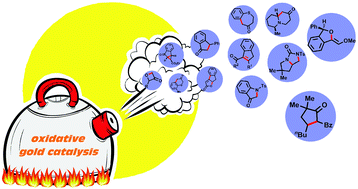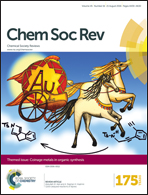Au-Catalysed oxidative cyclisation
Abstract
The two main strategies of gold-catalysed oxidative cyclisation are discussed in this tutorial. The first one employs nucleophilic oxidants as either internal or external nucleophiles. The inherently weak O-heteroatom bond in the oxidant enables the versatile reactivities of the initial gold-promoted adduct of the oxidant to alkyne, including its fragmentation into a highly reactive α-oxo gold carbene intermediate. The second features external oxidant-powered Au(I)/Au(III) catalysis, where the metal oxidation state changes during the catalytic cycle. These strategies have been applied toward the development of a variety of valuable synthetic transformations.

- This article is part of the themed collection: Coinage Metals

 Please wait while we load your content...
Please wait while we load your content...